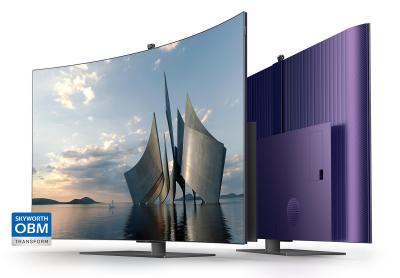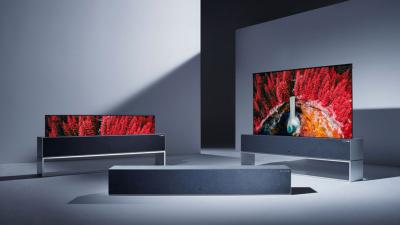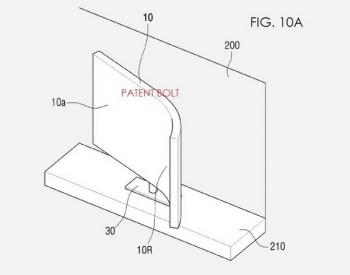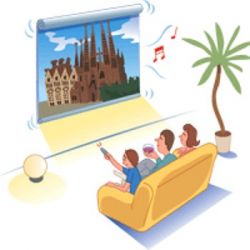What is an OLED?
OLED is a light-emitting diode built from thin films of organic electroluminescent material sandwiched between electrodes. Since the materials are luminescent, they produce light when the current is run through them. The direct-emission nature of OLEDs enable it to provide the best quality TVs on the market.
One of the main advantages of OLEDs is their flexible nature. This enables the production of bendable TVs. The idea is that such TVs can change from a flat screen to a curved one (with holds unique advantages for the viewers).
The advantages and disadvantages of curved panels
A curved TV can enhance the viewer’s immersive experience with its curved form, as the screen "wraps around. The curved screen has a curved trajectory similar to a person’s ‘Horopter Line’ allowing the maintenance of a constant focus. Another advantage of a curved TV is that the distance from the viewer is constant (unlike a flat TV in which the middle is closer than the edges). This means that in a flat TV there's a subtle image and color distortion which does not occur in a curved panel. The larger the flat screen and the closer the distance from the screen, the distortion becomes more noticeable.
A curved screen also feels larger and brighter compared to a flat TV. This, again, enhances the viewing experience. It is said that a viewer will feel that the size of a curved TV screen is larger than its actual size. Curved OLED TV also feels brighter because the light coming from the screen is focused on the center of the screen.
One final, and crucial advantage, is reduced reflections. The curved display eliminates reflections from ambient lighting on the sides, and it also reduces specular (mirror) reflections.
Nonetheless, voices arise arguing the disadvantages of curved OLED TVs: there is a claim that in order to get the benefit of a wraparound image, you need to be sitting in a pretty specific place. That sweet spot can be very small, possibly fitting only one viewer. Other faults arguably include limitation of viewing angles, elevated prices and, of course, looking less attractive mounted on a wall.
Curved TV launched at around 2013, but quickly fell out of fashion - and today very little curved TVs are sold, if at all.
Bendable OLED TVs
When people actually considered buying curved TVs, flexible OLED makers started to discuss the option of building bendable OLED TVs - a novel concept that allows a shift from flat to curved screen and vice versa at the press of a button. This enables viewers to enjoy both the flat and curved experiences in one set, encompassing both OLED’s superior image quality and the immersive experience of a curved TV. It can be neatly attached to a wall in its flat form, but curved at will to grant the ultimate viewing experience.
In 2021, Skyworth became the first company to release a commercial bendable TV, the 65-inch W82.

The W82 sports a 65-inch 120Hz WOLED TV panel (produced by LG Display) and features Dolby Vision, HDR10, Skyworth's AI Picture Quality 4K engine, VRR and 240Hz Crystal Motion OLED. The TV will start shipping in May 2021 in China for 29,999 Yuan (around $4,575).
Rollable OLED TVs
While bendable OLED TVs are interesting, another TV technology is becoming commercial - rollable OLED TVs. In 2020 LG started shipping the world's first rollable TV, the 65" 65RX.

Further reading
The latest bendable OLED TV news:
Samsung and LG to unveil bendable OLED TVs at CES 2014?
Back in May, The US PTO granted a new patent to Samsung that describes a bendable OLED TV. The idea is that you can use a remote control to bend the television so you'll get a better viewing angle. The TV will include special software that adjusts the image so it is not distorted by the bending. Today the Korea Times reports that Samsung will unveil a prototype bendable OLED TV at CES 2014 (January 7). LG will also unveil a similar unit.

The report does not include more technical information, they only say that the the display size will be "huge". The OLED TV will have a plastic substrate and a back panel that can deform the display. It is possible that SDC will only unveil their prototype in closed meetings.
Samsung granted a patent on a remote-bendable TV
The US Patent Office granted Samsung a new patent (#537228) that describes a bendable TV. The idea is that you can use a remote control to bend the television so you'll get a better viewing angle:

Samsung says that this TV uses a flexible display panel (probably an OLED TV, but it is not mentioned in the patent) and a back panel that can deform the display. In addition, the whole TV sits on a unit that can be rotated. The TV will include special software that adjusts the image so it is not distorted by the bending.
New Korean project led by LG aims to make flexible and transparent 60" UHD OLED panels by 2017
The Korean government is funding a new program ("Future Flagship Program") that will develop transparent and flexible OLED technologies with an aim to produce ultra high-definition 60" flexible OLED displays by 2017. The project will be led by LG Display, and will also include equipment-maker Avaco.
 Flexible OLED TV concept (Sony)
Flexible OLED TV concept (Sony)
The Korean Ministry of Knowledge Economy is spearheading the program, and they say that this technology may have a large impact on the Korean economy, creating 840,000 jobs and $56 billion in yearly exports. It will also help to widen the technological gap between Korea and China in the display sector. The Korean government chose several key technologies that will help to further develop the industry, and OLED is one of them.
Sony sees rollable large-screen OLED TVs in the future
Sony published an interesting interview with their display unit team about rollable OLED displays. Back in May (during SID 2010) Sony unveiled a new 4.1" rollable OLED display (with 423x240 resolution at 121ppi, 16.8 million colors - and the whole thing is just 80um thick). In the interview, Dr. Kazumasa Nomoto reveals that Sony's end target is a rollable large-screen OLED TV: "The time will come when the very idea that an enormous black box (TV) was ever placed in rooms will seem strange."

In the interview, the team discusses the new technologies that Sony created for this new display. First was a new Organic TFT based on a new material: a peri-
Xanthenoxanthene (PXX) derivative (this took Sony 5 years to develop!). Sony also developed a flexible gate driver circuit. Finally, an insulating layer for the O-TFT and OLED materials using flexible organic materials. Those three technologies enabled sony to create a rollable video display.
Pagination
- Previous page
- Page 3



